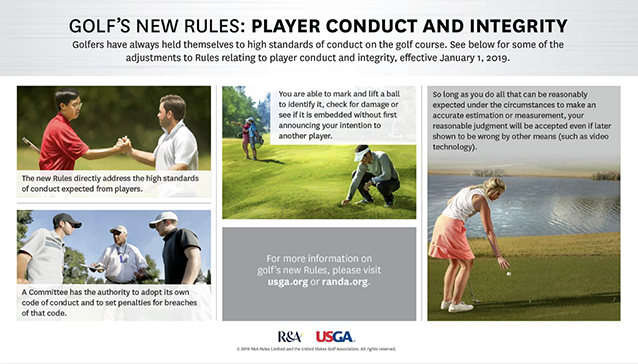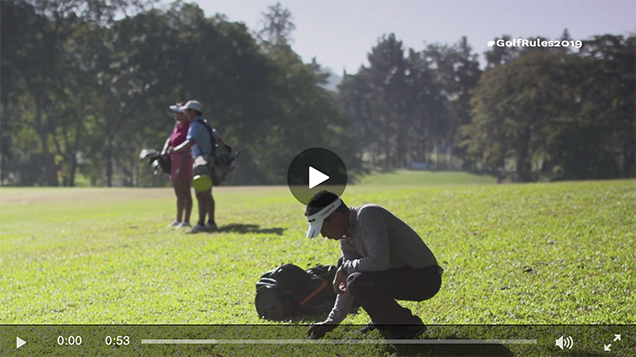Player Behavior
2019 Golf Rule Changes
Become comfortable with the rule changes to help you this season.
Topic 8 | Player Behavior
Rule – Expected standards of player conduct
The proposed new rules speak to the high standards of conduct expected from players.
2019 Rule: Rule 1.2a will consolidate the expected standards of player conduct:
- It will declare that players are expected to play in the spirit of the game by acting with integrity, showing consideration to others and taking good care of the course.
- It will unequivocally state the Committee’s authority to disqualify a player for any serious misconduct that is contrary to the spirit of the game.
- In place of the unclear concept of “breach of etiquette”, it will use the more direct and stronger phrases “misconduct” and “serious misconduct.”
Rule 1.2b will also give the Committee authority to adopt its own Code of Conduct and to set penalties for its breach (see Explanation for Proposed Rule Change – Code of Player Conduct).
Reasons for Change:
Golf is a sport in which high standards of conduct are expected from players, and the Rules should declare this in a clear and direct way.
Although the current Rule book has a separate Etiquette Section that covers the most important aspects of the spirit of the game:
- The priorities and emphasis of the section are unclear, as it also includes more general recommendations on a variety of topics, and
- The section does not have the force of Rules or naturally form part of a Committee’s powers.
Using Rule 1.2a to explain playing in the spirit of the game will help in:
- Giving more prominence to the expectation that all players will act with integrity, show consideration to others and take good care of the course, and
- Setting expectations so that players are on notice that serious misconduct in failing to meet those expectations could lead to disqualification
Rule – Code of player conduct
Committees are given authority to adopt their own code of player conduct and to set penalties for beaches of that code.
2019 Rule: Under Rule 1.2b, a Committee will be allowed to adopt a “Code of Conduct” that:
- Sets the Committee’s own standards for how players should conduct themselves, and
- May set penalties less than disqualification (such as a one-stroke penalty or a two-stroke penalty/loss of hole penalty) for a player’s breach of those standards.
The Committee will also still be able to disqualify a player for serious misconduct that is contrary to the spirit of the game, as emphasized in new Rule 1.2a (see Explanation for Proposed Rule Change – Expected Standards of Player Conduct).
Reasons for Change:
Some Committees have requested additional means under the Rules to allow them to address player conduct that is contrary to expected standards that are central to the game (such as courtesy and sportsmanship).
- In many cases, disqualifying a player for inappropriate behavior will be overly harsh - leaving Committees today with no way to penalize players for such behavior.
- This has been a particular concern for junior golf organizations whose mission often includes teaching young golfers how to act while on the course.
The proposed Rule change will give Committees flexibility to set and enforce standards of conduct specific to their competitions and players, should they choose to do so.
Rule – Elimination of the requirement to announce the player’s intent to lift a ball
When you have good reason to mark and lift your ball, you are no longer required to first announce your intention.
2019 Rule: In all three situations under the Rules (that is, Rule 4.2c, Rule 7.3 and Rule 16.4):
- A player will be allowed to mark and lift the ball and proceed under the Rule without needing first to announce this intention to another person or to give that person a chance to observe the process.
- But the player will still get a one-stroke penalty if he or she marked and lifted the ball without good reason to do so under that Rule.
Reasons for Change:
The Rules generally rely on the integrity of the player.
- In other relief situations, including when a ball may be lifted and played from a different place, players are allowed to proceed under the Rules without being required to involve another person in any part of the process.
Eliminating the announcement requirements for these three situations will simplify the Rules, bring consistency to the approach of trusting the player and eliminate an unnecessary procedural penalty for simply not informing an appropriate person.
This change should also speed up play because a player will no longer need to take the time to inform another player of the intent to lift and to wait to see if that other player wants to come over to observe the lifting and replacement of the ball.
Check out the VIDEO:
Rule – Reasonable judgment in estimating and measuring
A player's reasonable judgment will not be second-guessed based on later evidence.
2019 Rule: Decision 34-3/10, a new decision introduced in April 2017, will be incorporated into the Rules as Rule 1.3b(2) so that when the player estimates or measures a spot, point, line, area or other location, his or her reasonable judgment is accepted:
- If the player did all that could be reasonably expected under the circumstances to make a prompt and accurate estimation or measurement.
- This means that the player's reasonable judgment is upheld even if later shown to be wrong by other information (such as video technology).
Reasons for Change:
The Rules generally rely on the integrity of the player, and this is a natural and appropriate extension of this trust in the player.
There are many times when the Rules require a player to estimate or measure a spot, point, line, area or other location, such as when the player:
- Uses a ball-marker to mark a ball’s spot, and then replaces the ball, or
- Estimates the spot where the previous stroke was made when playing again under penalty of stroke and distance or when a stroke has been cancelled, or
- Needs to find a reference point or line for taking relief (such as the nearest point of complete relief or the line when taking unplayable ball relief), or to determine the extent of a relief area (such as measuring a fixed distance from a reference point).
- Estimates the location of his or her knee when dropping a ball.
Such judgments need to be made promptly, and players often cannot be precise in doing so.
So long as the player did all that could be reasonably expected under the circumstances:
- The player gets no penalty for small inaccuracies, even if an advantage is gained.
Accepting a player’s reasonable judgment limits the detailed analysis that can arise from the use of enhanced technology (such as video review when golf is televised).

